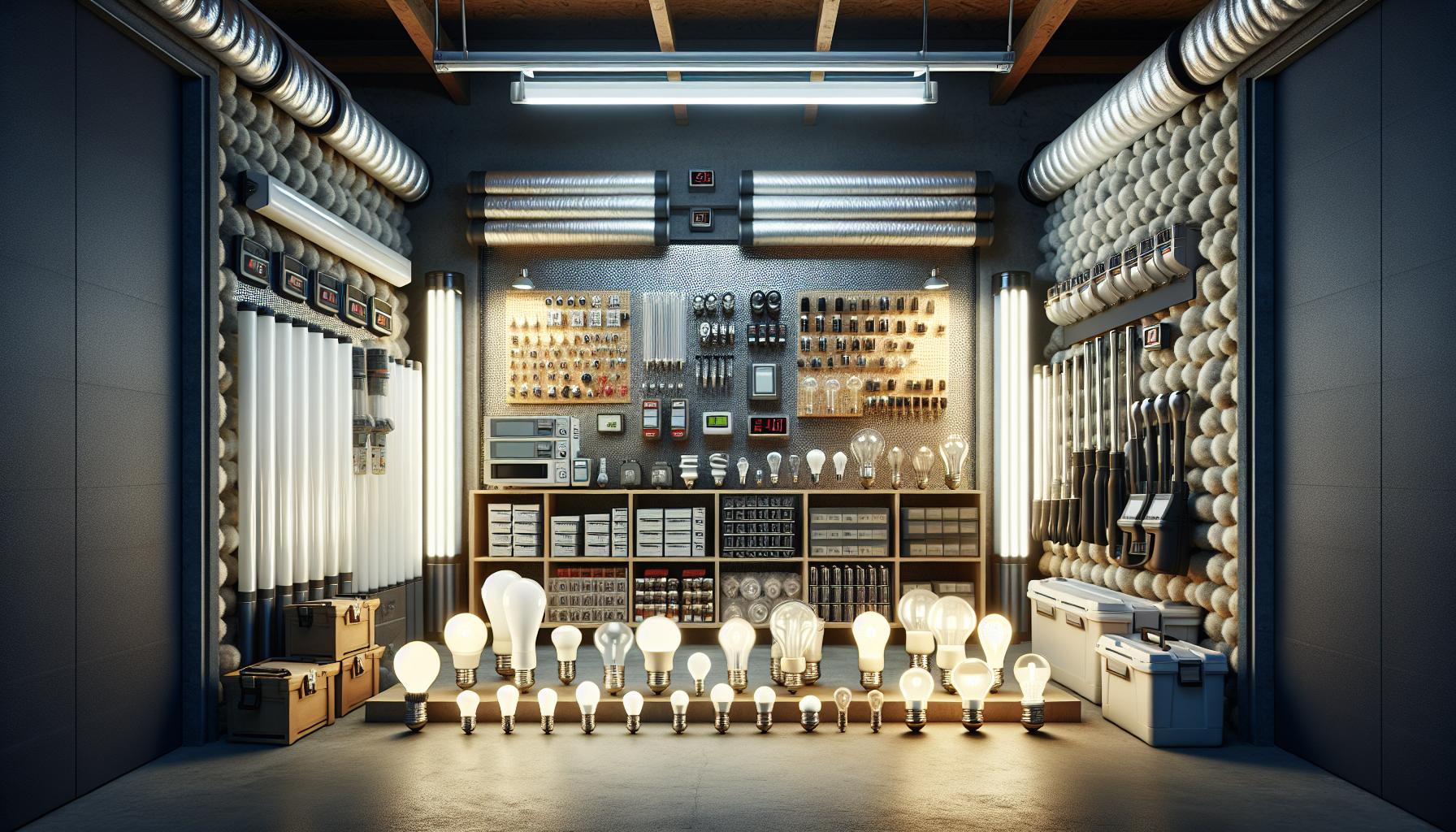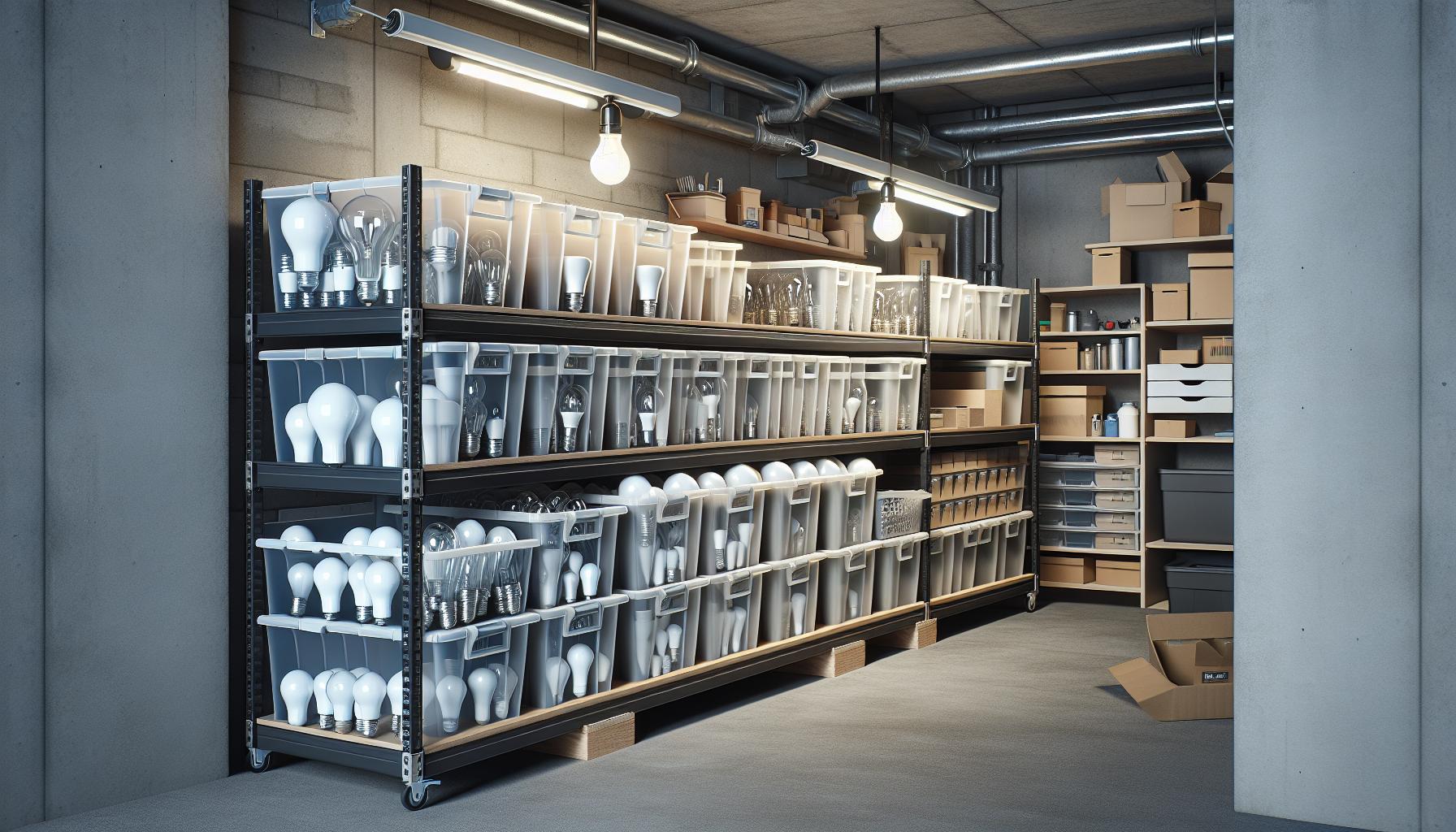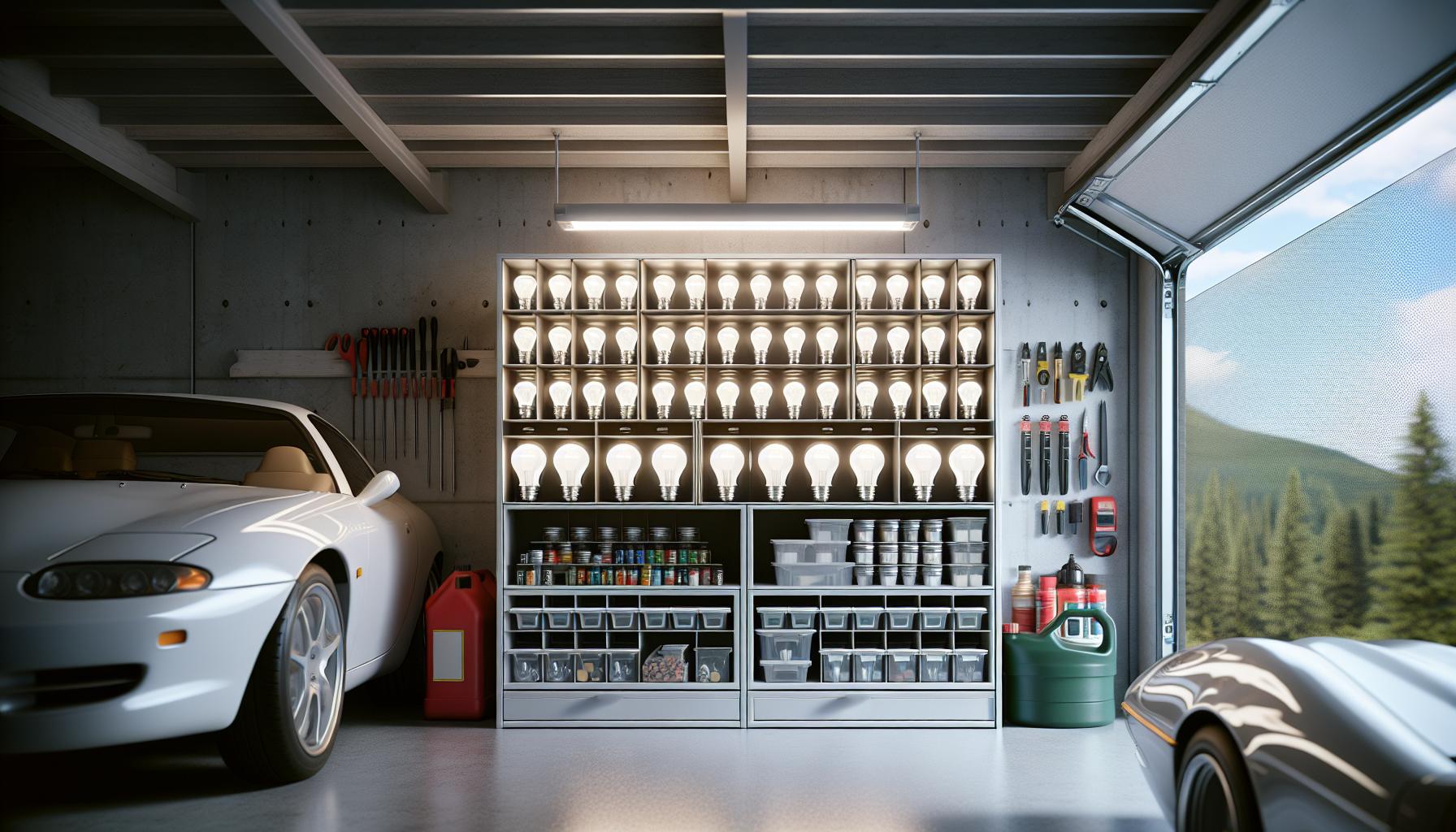Ever wondered if your garage is a suitable spot to stash away those extra light bulbs? You’re not alone! Many homeowners face the same dilemma when organizing their storage spaces.

Storing light bulbs isn’t just about freeing up your closet space; it’s about keeping them safe and functional for when you need them. Let’s shed some light on whether your garage can be the go-to place for your bulbs.
Understanding the do’s and don’ts of light bulb storage can save you from the hassle of a flickering light on a dark night. So, before you start clearing the shelves, let’s dive into what you need to know.
The Importance of Proper Light Bulb Storage
Storing your light bulbs correctly is vital for maintaining their longevity and performance. As you’re aware, light bulbs are more than just sources of light; they are sophisticated devices that demand careful handling.
Consider this: the filaments in incandescent bulbs are quite fragile; a sudden jolt can easily damage them. Moreover, LEDs and CFLs are sensitive to extreme temperatures, which means that how and where you store them can directly impact their efficiency. Did you know LEDs can lose brightness over time if exposed to high heat?
When tucking away your bulbs in the garage, you’re aiming for a space that’s dry, temperate, and free from potential breakage risks. Fluctuating temperatures and humidity—common in garage environments—aren’t just minor inconveniences. They pose serious threats to the composition of your bulbs. Corrosion and loosening of electrical components are the last things you want, especially when you’ve invested in high-quality lighting.
Whether you’re a DIY aficionado or a lighting enthusiast, consider these points for proper storage:
- Temperature Control: Your garage needs to be well-insulated to prevent extreme temperature changes. Bulbs are best preserved in a cool and stable environment that’s not subject to the whims of weather.
- Moisture Regulation: Keeping bulbs in a dry spot is essential. Moisture can seep into the base and cause corrosion, which is a surefire way to shorten a bulb’s lifespan.
- Safe Positioning: Always ensure that bulbs are stored in a manner where they cannot roll away or be knocked over. Original packaging often provides the ideal shape and cushioning to protect them until you need them next.
Being diligent about how you store your extra light bulbs might seem like a minor task, but it’s these details that make a big difference. Taking the time to ensure your spares are stored safely means you’re less likely to encounter the headache of premature bulb failure. And, as you can guess, nothing interrupts a well-planned home improvement project like a flickering or dead light.
Factors to Consider

When deciding whether to store your light bulbs in the garage, there’s a bit more to it than just tossing them on a shelf. As an avid DIY enthusiast and lighting aficionado, you’ll want to account for several key factors to keep your bulbs shining bright.
Temperature Fluctuations play a major role in the lifespan of your bulbs. Especially if your garage isn’t climate-controlled, the wide temperature swings from blazing hot summers to freezing winters can shorten the life of your bulbs. LEDs are particularly susceptible to heat, as it can degrade the sensitive components within.
Humidity is another beast altogether. Excess moisture can wreak havoc on metal contacts and lead to corrosion. If you’re in a region with high humidity, or your garage is prone to dampness, it’s something to be wary of. Ensure your bulbs are stored in a way that minimizes exposure to moisture.
Think about Vibrations and movement. Garages typically see a lot more action than your average storage closet. The rumble from garage door openers, tools, and cars coming and going can jostle bulbs and cause delicate filaments to break in incandescent bulbs or connections to loosen in LEDs and CFLs.
Lastly, Pests and Rodents might not seem like an immediate concern, but these critters have an odd penchant for nibbling on packaging and even the bulbs themselves, given the chance. Storing bulbs in sturdy, sealed containers can help prevent an unexpected headache caused by tiny intruders.
Remember to always store your bulbs Upright in their original packaging—or a suitable alternative—to prevent them from rolling around and getting damaged. If your garage can mitigate these risks, you’ve got the green light. But if there are any doubts, it might be wise to consider a more controlled environment for your luminary investments. Keep exploring more storage tips to ensure every flick of the switch illuminates your home with the warm, comforting glow you’ve worked so hard to perfect.
Temperature and Humidity Control
« Are Light Bulbs Universal? The Truth About LED Compatibility
Can Light Bulbs Catch Fire? The Hidden Risks of LED Lighting »

Storing your light bulbs in the garage may seem like a convenient solution, but it’s vital to consider the conditions they’ll be facing. Temperature fluctuations and humidity levels in garages can be extreme, ranging from freezing cold in the winter to sweltering heat in the summer. Both extremes can shorten the lifespan of your bulbs, especially for LEDs and CFLs, which contain electronic components sensitive to those changes.
To protect your bulbs, you need to create an environment within your garage that mimics the stable conditions of your house. Ideally, you want the temperature to stay between 40°F and 70°F. Using a thermometer can help you monitor the temperature. As for humidity, it should remain below 50% to prevent damage to the bulb’s components. Prolonged exposure to high humidity can lead to corrosion of metal parts and the degradation of the electronic circuits within energy-efficient bulbs.
If your garage tends to get damp, consider using a dehumidifier or silica gel packs to keep the air around your light bulbs as dry as possible. Remember, moisture is an enemy to longevity in light bulbs, triggering corrosion that can lead to premature failure.
In some cases, you might even look into insulating your garage or installing a climate control system to maintain a consistent temperature and humidity level. This can be a more costly solution but might be worth the investment if you’re storing a significant number of bulbs or other sensitive items.
Keep a close eye on these environmental factors and take necessary measures if you notice that conditions are starting to deviate from the ideal. By maintaining a controlled climate in your storage area, you’re giving your light bulbs the best chance to shine bright when it’s their time to perform on stage.
Protection from Physical Damage

Storing your light bulbs in the garage means you’ll have to shield them from physical harm. Garages can be treacherous places for something as delicate as a light bulb, with cars moving in and out, tools and machinery vibrating, and the risk of accidental impacts ever-present.
To start, keep your bulbs in their original packaging as much as possible. Manufacturers design this packaging to protect the bulb from shocks and impacts that can occur during shipping — and these protections are just as effective in your garage. If the original packaging isn’t available, opt for sturdy containers that won’t collapse or allow the bulbs to rattle around:
- Plastic storage bins with dividers
- Cardboard boxes with sectioned inserts
- Custom bulb storage solutions available online
Next, consider the placement of your light bulb storage. It’s best not to store bulbs on the floor where they’re most susceptible to being stepped on or knocked over. Instead, choose a shelf that’s out of the direct line of traffic but still easily accessible. Ensure it’s a stable surface that doesn’t shake or vibrate; even small vibrations over time can weaken the integrity of the bulb’s components.
Moreover, if you’re storing bulbs with more robust casings, like some LED models, you still shouldn’t get complacent. Regardless of the durability claims, these bulbs are not impervious to damage. Keeping them secure and away from potential harm is key.
Finally, take and inventory periodically. Over time, you might accumulate more bulbs than you need, or some may outlive their usability without ever being screwed into a socket. Ensuring you have just what’s necessary reduces clutter and the risk of damages from overcrowded storage spaces, which is as helpful for organization as it is for protection.
Avoiding Exposure to Chemicals

When stashing your light bulbs in the garage, be aware that it’s often a haven for various chemicals that could potentially harm them. You might not think twice about it, but the fumes from paints, solvents, or even that gas can in the corner can degrade bulb materials over time. You’re looking to keep those bulbs glowing bright – not subject them to a cocktail of chemicals.
Paints and other substances off-gas volatile organic compounds (VOCs), which can corrode the metal bases of light bulbs. Here’s a tip: Place your bulbs away from these chemicals. Ideally, store them in a cabinet or on a high shelf, far from any spills or fumy substances. Think about it, the last thing you want is your lighting project delayed because of corroded or dysfunctional bulbs.
While LEDs are touted for their durability, they’re not invincible, especially to corrosive substances. Likewise, CFLs can be vulnerable to chemical vapors, which can affect their phosphor coating and, in turn, their efficiency.
To preserve your bulbs in tip-top shape, consider these measures:
- Regularly ventilate your garage to disperse any potentially damaging vapors.
- Check the integrity of the containers where chemicals are stored; make sure they’re sealed and not leaking.
- If you’re a DIY enthusiast who often uses chemicals in your projects, consider investing in an air purification system to reduce the potential for damage.
Balancing the air quality in your garage with your storage needs doesn’t have to be a puzzle. Just by being mindful of these possible chemical interactions, you’re one step closer to ensuring those bulbs are ready for action when you flip that switch.
Best Practices for Storing Light Bulbs in the Garage
When it comes to stowing away those extra bulbs, your garage can be a sanctuary or a hazard—it all depends on how you handle the storage process. You’re already clued in on the importance of shielding your bulbs from knocks and chemical woes, but there’s more to consider for optimal longevity of your lighting supplies.
First up, take advantage of shelving. By elevating bulbs off the ground, you mitigate the risk of accidental floods or pests treating your bulbs like a midnight snack. Ensure shelves are secured firmly and far from the hustle of daily garage activities. Shelving also aids in organization, so you’ll always know exactly where to find the bulb you need when you need it.
Here’s something you might not have thought about: rotating your stock. Just like the pantry in your kitchen, you want to use the oldest light bulbs first. Keep track of when you bought your bulbs and use them in chronological order. This simple step avoids the disappointment of finding that a bulb has gone kaput before ever being screwed in.
If you’re a fan of DIY labelling, now’s the time to shine. Label shelves and containers with the bulb types and wattages. This will save time and protect bulbs from being mixed, jostled, and potentially damaged in a hurried search. Efficiency for the win!
Let’s not forget about padding. While keeping bulbs in their original packaging is smart, you can add an extra layer of security with some DIY cushioning. Foam peanuts, bubble wrap or even repurposed newspaper can help absorb shock if a container is accidentally dropped or bumped.
Speaking of protection, don’t let your light bulb storage turn into a game of Jenga. Stable stacking is key; place heavier, sturdier boxes at the base and lighter ones on top. You’re building a secure bulb fortress, not a domino setup ripe for disaster.
Remember, your garage is more than just a parking spot for your car. It’s also home to various DIY projects, tools, and now, a well-organized light bulb haven. With these strategies in place, you’ll keep your garage-lit escapades hassle-free and illuminate your home effectively whenever a bulb decides to retire.
Conclusion
You’ve got all the tips you need to turn your garage into a light bulb sanctuary. Remember, keeping your bulbs safe means they’ll be ready to shine when you need them. With a little organization and some DIY savvy, you’ll protect your bulbs from the elements and extend their life. So take a moment to elevate, label, and cushion your light bulb storage today. Your well-lit home will thank you for it!
Frequently Asked Questions
Why is proper light bulb storage important?
Proper light bulb storage is crucial for extending the longevity and performance of bulbs. It prevents damage and corrosion to fragile incandescent bulbs and sensitive LEDs and CFLs.
What conditions should be avoided when storing light bulbs?
Light bulbs should be protected from extreme temperatures, humidity, vibrations, and pests. These conditions can severely affect the bulbs’ integrity and functionality.
Where should I store my light bulbs?
It’s best to store light bulbs in a dry, temperate, and well-insulated environment, such as a garage, to keep them safe from external damage.
How should I keep my bulbs in storage?
Bulbs should remain in their original packaging or within sturdy, sealed containers to prevent them from rolling, being knocked over, or being affected by pests.
What are some best practices for storing light bulbs in the garage?
Elevate bulbs off the ground on shelves to avoid floods, rotate stock to use the oldest bulbs first, label shelves for organization, add cushioning for protection, and stack boxes stably.
Is it necessary to use the original packaging for light bulb storage?
While not always necessary, using the original packaging can offer the optimal level of protection due to its design to keep the bulb secure during transport and storage.




